9) YOUR SF/F TOP-TEN LISTS
We’ve asked folks to prepare a SF/F top-ten list on any science fiction, fantasy, or horror topic—for example, top ten classic Star Trek episodes, or top ten genre novelists, or top ten sci-fi film sequels; it’s your choice as to the specific topic.
While we’ve included a few sample lists below, this portion of the meeting will take place largely on Zoom, where each participant will have opportunity to present their list. Include, perhaps, a few illustrative photos which can be shared with the group as you impart your top ten, and be prepared to field questions and/or, perhaps, defend your choices!
Those unable to join our video chat today can still submit in writing their own SF/F top-ten list via this post’s “Leave a Comment” option. So, again, we’re looking for your sci-fi, fantasy, or horror top-ten; could be, for instance, top ten space operas, top ten time-travel stories, Hugo-winning novels, classic sci-fi films, genre TV shows, spaceships, movie monsters, scariest horror movies, comic book superheroes, etc.
Include a quick description or outline of each of your entries and explain why you’ve included each, and why your fellow genre fans might also enjoy the selections you’ve listed.
My Top Ten Dinosaur Movies
By Keith Braithwaite
I’ve been interested in the prehistoric world since childhood, and was always thrilled to take in a dinosaur movie whenever possible. The two essential criteria I employ for evaluating what makes for a good, enjoyable dinosaur flick are, first, that the story be an entertaining, high-concept, quality adventure worthy of my time, and second, that there be featured a fair number of dinosaurs brought to life on screen by, preferably, top-notch, but at least respectable visual effects wizardry.
Of course, that the characters have appeal and the cast deliver, at minimum, competent performances is also important, but not essential; I’m here for the dinosaurs! Getting the science right is near-impossible, so I don’t worry too much about that, quite prepared as I am to suspend my disbelief and just enjoy the show.
1) Jurassic Park (1993)
This Steven Spielberg-directed blockbuster gets top marks from me in all categories—story, characters, cast, special effects, musical score, even the science, which sounds almost possible—and ushered in an amazing new method of convincingly bringing dinosaurs to spectacular life on screen. It’s an exhilarating adventure and the dinosaurs are awesome to behold.
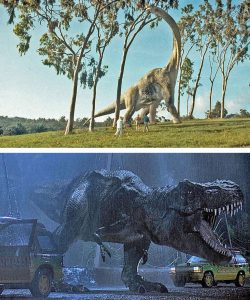
2) The Valley of Gwangi (1969)
Set at the turn of the 20th century, a time when such wonders as lost worlds and forbidden valleys still seemed plausible, this one’s a rollicking ride pitting cowboys against dinosaurs brought to life on screen by the late, great Ray Harryhausen, who was, and remains the unrivaled master of stop-motion animation. His titular Allosaurus is one of the finest Hollywood dinosaurs ever created. The sequence in which cowboys on horseback surround and attempt to rope Gwangi is, alone, worth the price of admission!
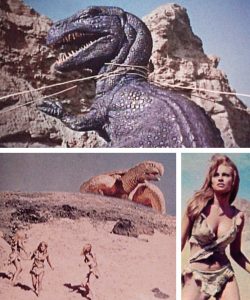
3) King Kong (1933)
While Kong, a giant gorilla with a thing for blondes, is the star of this iconic monster movie, half the story takes place on the big ape’s Skull Island home, a tangled-jungle wilderness populated by numerous dinosaurs. Stop-motion pioneer Willis O’Brien and sculptor/model-maker Marcel Delgado delivered the goods with special effects trickery that holds up quite respectably even today, almost a century later! Kong’s jaw-dropping wrestling match with a Tyrannosaurus-rex and his clifftop fight with a Pterodactyl are highlights.
4) Jurassic Park III (2001)
This Jurassic Park sequel has its creative flaws, but the fast-paced story isn’t half bad and the dinosaur action superb. I rank it this high on my list purely on the strength of the star dinosaur, a massive Spinosaurus that provides plenty of thrills. Jurassic Park’s Dr. Alan Grant is back, joined by fresh faces who acquit themselves fairly well.
5) One Million Years, B.C. (1966)
Harryhausen again, who was hired by London-based Hammer Film Productions to animate the dinosaurs for this tale set in a prehistoric past of dubious veracity. The story follows the adventures of Tumak, banished from his Rock tribe, and the beautiful Loana, of the Shell people, who meet and enjoy something of a stone-age Romeo-and-Juliet kind of thing, with each drawing suspicion, jealousy, and fear from the other’s clan. Stills of Raquel “Loana” Welch wearing her famous animal-hide bikini soon became an emblematic image of the swinging ’60s. And while I give the producers points for taking a swing at it, creatively, I’m not sure if the made-up cave-people languages spoken throughout the entire picture quite work.
But never mind all of that; there’s lots of cool dinosaur encounters to relish, including Tumak’s fight with and impressive spearing of a young Allosaurus that attacks the Shell people’s village, and an epic square-off between a Ceratosaurus and a Triceratops.
A volcanic eruption in the closing reel wipes out almost everything and everyone, leaving survivors Tumak, Loana, and a handful of other members of both tribes to forge a new future together.
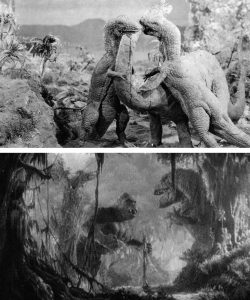
6) The Lost World (1925)
From the silent-movie era comes this magnificent adaptation of the celebrated 1912 Arthur Conan Doyle novel about an expedition to a South American plateau where living dinosaurs are believed to roam. Before they brought King Kong and the other denizens of Skull Island to the screen with their ground-breaking movie magic, the above-mentioned Willis O’Brien and Marcel Delgado created for this film a sweeping prehistoric mesa on which ranged multiple species of stop-motion dinosaurs—carnivores Allosaurus and Tyrannosaurus-rex, herbivores Stegosaurus, Agathaumas, Triceratops, Trachodon, Brachiosaurus, and others. Easily the best and most memorable early example of outstanding cinematic sci-fi adventure, with dinosaurs playing a prominent part.
7) When Dinosaurs Ruled the Earth (1970)
The success of One Million Years, B.C. resulted in more such films from Hammer, including this title, practically a carbon copy of its 1966 forerunner, right down to the use of a concocted prehistoric language throughout! Actress and Playboy model Victoria Vetri stepped into the Raquel Welch role for this one, and stop-motion animators Jim Danforth and David Allen handled the dinosaur action, delivering excellent results. Dinosaurs featured included a Plesiosaurus, a charging Chasmosaurus, a quadrupedal Megalosaurus, seemingly patterned on the mid-19th century Crystal Palace Park sculpture created by Benjamin Waterhouse Hawkins, and a giant Rhamphorhynchus.
8) Cesta do pravěku, or, in English, Journey to the Beginning of Time (1955)
This is a Czechoslovakian science fiction film about four boys boating on a river that mysteriously draws them progressively further back through time the more they row upstream, affording them a fantastic opportunity to observe the prehistoric flora and fauna of Earth’s different geological time periods.
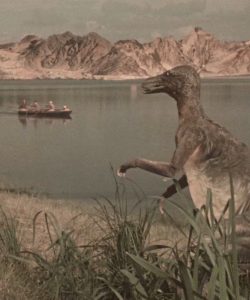
I remember watching an English-language dub of this film many moons ago in my elementary school classroom; there was a distinct documentary feel to the piece as the boys appeared to know a lot about the various dinosaurs and other prehistoric beasts they came across along their way. The animals were depicted behaving naturally in marked contrast to most dinosaur films, which cast their prehistoric stars as movie monsters and placed them in contrived situations for dramatic purposes.
I know now that this movie was not a documentary, per se, but its unusual narrative style made it seem so, and the production has apparently influenced such natural history documentaries as the BBC’s 1999 Walking with Dinosaurs series.
An American version released in 1966 replaced some sequences with newly filmed footage and cut the movie into chapters for serialization; this is probably the film I saw in school so many years ago. My boyhood self was struck by the wonderful imagery, which was inspired by the paleontological paintings of eminent Czech artist Zdeněk Burian. Director Karel Zeman recreated for the screen some of Burian’s depictions using a combination of 3-D models, stop-motion, puppetry, full-sized models, animated 2-D “profile models,” and painted backdrops and matte paintings—essentially, the filmmaker used every technique available to him at the time to realize his vision.
The movie offers not only numerous dinosaurs, but prehistoric mammals and birds like the Mammoth and the Phorusrhacos.
9) The Land That Time Forgot (1974)
Based on the 1918 Edgar Rice Burroughs novel of the same name, this movie delivers on story but largely fails on the presentation of the featured dinosaurs, which are hand puppets and string-operated marionettes, stiff and not remotely convincing. Thus, while my above-outlined first criteria is sufficiently fulfilled, here—you can’t beat a grand, old-fashioned Burroughs fantasy/adventure tale, after all—my second is most definitely not!
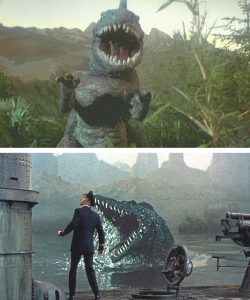
10) Planet of Dinosaurs (1977)
Survivors of a spaceship crash must survive on an Earth-like planet populated by dinosaurs in this low-rent sci-fi actioner. Producer/director James K. Shea spent almost all of his meagre budget on the stop-motion dinosaurs of the piece, and came away with pretty good results that won the film awards based on the quality of that animation. But the rest of the movie—script, cast, props, etc.—is weak, at times laughably so. And so this final entry on my list is the opposite of the previous one, with my first criteria unmet and my second satisfied.
My Top Ten Ray Bradbury Short Stories
By Keith Braithwaite
One of the first genre writers I read as a youngster was Ray Bradbury; I’ve always enjoyed his evocative, poetic prose and turn of phrase, and he came up with some interesting and uplifting, weird and sometimes terrifying ideas for the 600 or so short stories he wrote over his lifetime. If not all, I’ve read many of them, and it’s hard to boil my favourites down to just 10, but below are those that came to mind as I was pondering which to include for this exercise.
The best of Bradbury’s short-story oeuvre can be found in such collections as R is for Rocket, S is for Space, The October Country, The Machineries of Joy, The Illustrated Man, The Martian Chronicles, and others. Many of these books have been in print in various editions for decades.
For those who haven’t read these stories, spoilers, of course, are inevitable, here, so proceed accordingly.
1) “A Sound of Thunder” (1952)
A time-travel classic about a hunting expedition to bag a dinosaur, and in which the consequences of even a minor change accidentally made in the prehistoric past—in this case, treading on a butterfly after inadvertently stepping off of a special protective path used by Bradbury’s group of time-traveling safari hunters—ripple through the millennia to manifestly change the world from which the group have come.
Plus, there’s a T-rex, which my dinosaur-crazy boyhood self found pretty cool!
2) “Boys! Grow Giant Mushrooms in Your Cellar” (1962)
While I first read the story under this title, it was originally published as “Come Into My Cellar” in Galaxy Science Fiction. Without giving too much away, this is a subversively clever alien-invasion story in which the extraterrestrial threat comes in the mail! A slow-burning dread permeates the piece, building to a chilling climax.
It’s been adapted several times for the screen, most effectively as “Special Delivery” in 1959 for Alfred Hitchcock Presents.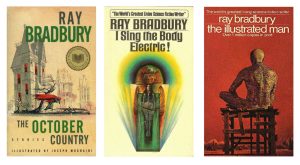
3) “The Fog Horn” (1951)
Originally published as “The Beast From 20,000 Fathoms” in The Saturday Evening Post, this story was the inspiration for the 1953 Ray Harryhausen monster movie of the same name. The two Rays, by the way, were fast friends for much of their lives.
This is a story of loneliness, that of the seasoned keeper and his apprentice manning an isolated lighthouse, and of the ancient sea monster which responds to the sound of the lighthouse’s fog horn, thinking it the call of another of its kind. The keepers speculate on whether the animal is the last of its species.
Human or beast, we all need companionship, love, and suffer to the point of anger without it, as does the sea monster when the keepers switch off the fog horn, enraging the tormented creature, which then destroys the lighthouse.
4) “Dark They Were, and Golden-Eyed” (1949)
Originally published as “The Naming of Names” in Thrilling Wonder Stories, this is the story of colonists sent to Mars during a war on Earth to establish a settlement there. Gradually, they change, slowly becoming Martians, quite literally, and finally deserting their homes for the ancient Martian villas in the mountains!
Five years have passed, the war has ended, and an Earthship arrives to recover the colonists. The crew find the settlement abandoned, but encounter a community of Martians in the mountains who exhibit a remarkable command of the English language.
5) “The Dragon” (1955)
Originally published in Esquire, this is an odd little fantasy piece about a pair of knights on a mission to slay a dragon. It is nighttime on a seemingly timeless moor, and the two men sit at their campfire fearfully anticipating what is to come, a hulking, shrieking behemoth belching fire and smoke. Convinced of certain failure, for this monster has killed all who have faced it before, they nevertheless ready for battle, strapping on their armour. The dragon’s wail can be heard as it thunders closer and one of the knights charges at the quarry, lance striking, and buckling, just under an “unlidded yellow eye,” while the other knight and his mount are flung fatally against a rock as the dragon shoulders past.
The scene shifts to the cab of a steam locomotive, where the engine crew are both excited and bewildered by what looked for all the world like a charging knight-in-armour on the tracks. “We hit him!” one man exclaims. “You goin’ to stop?” The other replies, “Did once; found nothing. Don’t like to stop on this moor. I get the willies. Got a feel, it has.”
6) “The Long Rain” (1950)
First published as “Death-by-Rain” in Planet Stories, which kind of suggests the outcome of the tale, this one is set on Venus. Four men whose rocket has crashed are trekking through the jungle in the incessant rain—it’s nearly always raining on Venus—attempting to reach a “Sun Dome,” one of over a hundred dry, warm shelters lit by a miniature sun and stocked with provisions. The indigenous Venusians, however, take every opportunity to destroy these structures.
“It was a hard rain, a perpetual rain, a sweating and steaming rain; it was a mizzle, a downpour, a fountain, a whipping in the eyes, an undertow at the ankles; it was a rain to drown all rains and the memory of rains,” Bradbury writes, establishing the deluge as an ominous force. The constant, unrelenting drumming of raindrops against one’s head and body is enough to drive a person insane and in the finale, as the sole survivor of this ordeal finally finds safety, we are unsure if he has, in fact, lost his mind and is hallucinating.
7) “There Will Come Soft Rains” (1950)
The title of this story was taken from a World War I-era poem by Sara Teasdale—Bradbury was a lover of poetry—dealing with nature’s indifference to the outcome of the war, and to the survival at all of mankind.
After a nuclear war has obliterated the town of Allendale, California, an automated house stands still, having survived the conflagration, and continues to function. A morning alarm announces that it’s time to wake up, and provides the date, August 4, 2026; breakfast is automatically prepared, toast, eggs, bacon, two cups of coffee and two glasses of milk; outside, the lawn sprinklers are activated.
But the house is empty. The family that lived here was vapourized in an atomic blast. All that remains of them are the silhouettes of very their last moments—mowing the lawn, gardening, tossing a ball in the yard—visible against a wall the paint on which has otherwise been burned off. Tiny robotic mice scurry about, attending to cleaning chores. The family dog has somehow survived the blast and, starving and suffering from radiation poisoning, whines at the door and is let in. The animal searches the house for the family, soon dies, and is whisked away to the incinerator in the cellar by a phalanx of the robot mice.
At 9:05PM, the lady of the house is asked which poem she would like to hear this evening. No answer. After a moment, the house randomly selects Sara Teasdale’s “There Will Come Soft Rains” and begins to recite the rhyme.
The house is finally destroyed that night when a fire breaks out in the kitchen and quickly spreads throughout the structure. The following morning, only a single wall remains standing, and the house’s malfunctioning electronic voice emanates from a speaker box announcing, over and over and over, that the date is August 5, 2026.
There were two versions of the story, one published in Collier’s magazine, the second as a chapter of Bradbury’s fix-up novel The Martian Chronicles. The dates given differ between the Collier’s and Martian Chronicles versions; with the latter, definitive edition, Bradbury wanted to commemorate the anniversary of the atomic bombing of Hiroshima, which took place on August 6, 1945, local time, or August 5 on this side of the International Date Line.
8) “Kaleidoscope” (1949)
Originally published in Thrilling Wonder Stories, the story involves the aftermath of a rocket explosion which has scattered the crew out into space in all directions. Safe for the moment in their spacesuits, the men know they are all, in the end, doomed. They have about an hour during which time they’ll be able to communicate amongst themselves as each drifts further away towards his ultimate fate. Each man looks back on his life, and each handles his impending death differently—disbelief, madness, resignation.
Reflecting on his abysmal and unfulfilling existence, lead protagonist Hollis is jealously resentful of fellow crewmember Lespere’s life of wild abandon, many women, and good times. For his part, Lespere is pleased, as the end nears, to have his memories of a satisfying life well lived, whereas Hollis laments that he’s only ever dreamed of such a life as his colleague’s. There is in his attitude, now, a meanness towards Lespere, and he is taken aback by this realization. He had never been a mean person, had never dared. By tomorrow night, he expects to fall into Earth’s atmosphere and burn up “like a meteor,” and he wonders what he might do, if there is anything he can do at this point, to make up for the appalling and empty life he has lived.
In his final moments, Hollis wonders if anyone will see him. Far below, on a country road, a young boy spies a shooting star and excitedly alerts his mother. “Make a wish,” she tells her son.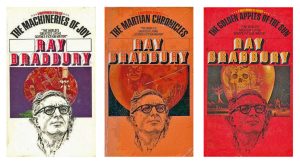
9) The Smile (1952)
Originally published in Fantastic, this one appealed to the artist in me. War has decimated nearly all vestiges of civilization and in the rubble of this post-apocalyptic future, remnants of pre-war times are disdained by the ragged survivors, who hate anything connected to that past, a past which wrought the deplorable misery of their present.
Tom is a young boy who lines up early one morning to take part in one of the periodic festivals dedicated to desecrating traces of the past, like a book-burning or the recent destruction of the last motorcar by sledgehammer. Today, people are lining up to spit on a painting that has been set up in the town square.
But when Tom’s turn finally comes and he stands before the work of art, he stares transfixed at this exquisite portrait of a young woman—the Mona Lisa. He has heard tell that she smiles, and finds his mouth dry and unable to yield any spittle. The crowd urge him to get on with it, but all he can articulate is that the subject of the painting is beautiful.
An official on horseback approaches with an announcement, which he reads aloud for all to hear: it has been decided that the portrait be handed over to the gathered populace so that they may participate in the destruction of—
Before he can finish, the crowd surges forward, Tom carried along in the melee of people grabbing at the painting, ripping and shredding the canvas into confetti, splintering the painting’s frame. In blind imitation of the mad throng, Tom tears at the painting and comes away clutching in his hand a small scrap of the canvas. He runs home with it and later, in the quiet of nighttime, lays awake, still clutching his tattered prize. The rising moon casts a cold light upon him, and he sees what is painted on the piece of torn canvas he holds in his hand: the smile, the lovely smile, warm and gentle.
With a bit of dialogue, Bradbury does address the fact that the Mona Lisa was painted on wood, not canvas; the crowd is lining up to spit on a copy, the characters conclude, but no matter.
10) “The Murderer” (1953)
First published in Bradbury’s short story collection The Golden Apples of the Sun, this one appeals to me even more today in this age of social media than it did when I first read it in the early 1970s.
Told through the literary device of a psychiatrist’s interview with a prisoner, the story involves the virtual assault of technology on a near-future society where people are under a constant barrage of communication by phone, intercom, radio, and other gadgetry. Sound familiar?
As the prisoner, who calls himself “The Murderer,” lists and details his various massacres of noisy, incessantly nattering machines, we learn that he was driven to extreme action against the offending contraptions because he found himself unable, ever, to escape the ceaseless demands of a world addicted to communication. Simply desiring a little peace and quiet, the man rebelled and violently smashed to pieces the machines that rang and buzzed and questioned and advised and babbled and never left him alone for so much as an instant. In the end, he is quite content to remain in the care of the state, freed as he is, now, from the burden placed upon him by communications technology and a society obsessed with it.
Before returning to his cell, the prisoner predicts that a revolution is coming, that his actions were just the beginning. “I’m the vanguard,” he states, “of the small public which is tired of noise and being taken advantage of and pushed around and yelled at, every moment music, every moment in touch with some voice somewhere, do this, do that, quick, quick, now here, now there…. It was all so enchanting at first. The very idea of these things, the practical uses, was wonderful. They were almost toys, to be played with, but the people got too involved, went too far, and got wrapped up in a pattern of social behavior and couldn’t get out, couldn’t admit they were in, even.”
Noting that the man seems strangely happy, the doctor exits the room, reports that the prisoner is convivial but out of touch with reality, and returns to the familiar, cacophonous environment of unremitting electronic blather.
My Top Ten Comic-Book Superhero Sobriquets
By Keith Braithwaite
Just as Habs great Maurice Richard was dubbed “The Rocket,” or master Hollywood make-up artist Lon Chaney “The Man of a Thousand Faces,” so too are many superheroes bestowed with descriptive tags, sometimes several. Here are my favourites:
1) The Dark Knight—Batman; Gotham City’s guardian boasts numerous appellations—Caped Crusader, Cowled Crime-Fighter, World’s Greatest Detective—but this one, I believe, paints the definitive picture of the character.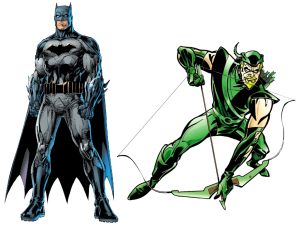
2) The Children of the Atom—mutants; collectively, the mutant community in Marvel’s X-Men universe.
3) The Man of Tomorrow—Superman; a difficult choice, but I picked this one over The Man of Steel and The Last Son of Krypton because The Man of Tomorrow has a positive, hopeful, optimistic ring to it, as befits the character.
4) The Sentinel of Liberty—Captain America; a tad jingoistic, perhaps, but given the character’s origin story, appropriate.
5) The Sorcerer Supreme—Doctor Strange; actually, this is his formal title as Earth’s protector against threats magical and mystical.
6) The Emerald Archer—Green Arrow; a classy label for this guy, and a nice bit of alliteration.
7) The Scarlet Speedster—The Flash; basically, that’s him in a nutshell, and there’s that lyrical alliteration again.
8) The Amazing Amazon—Wonder Woman; an apt description of this princess of Themyscira, and still more lovely alliteration.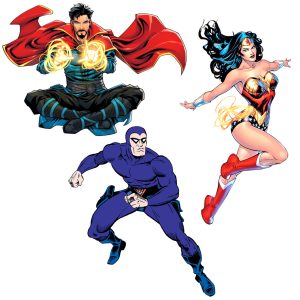
9) The Antlered Avenger—MooseMan; okay, no more alliteration… I promise! But allow me to pat myself on the back, here, as I came up with this tag in the process of developing a star character for MonSFFilms’ 2005 superhero spoof, and I think it’s a pretty good one!
10) The Ghost Who Walks—The Phantom; with one foot in pulp magazines and the other in superhero comics, he was so named because he seems never to die and has been around for hundreds of years. In fact, generations of crime-fighters have assumed the Phantom mantle. He was the first costumed crime-fighter to don a skin-tight suit, which subsequently became standard apparel for superheroes.

